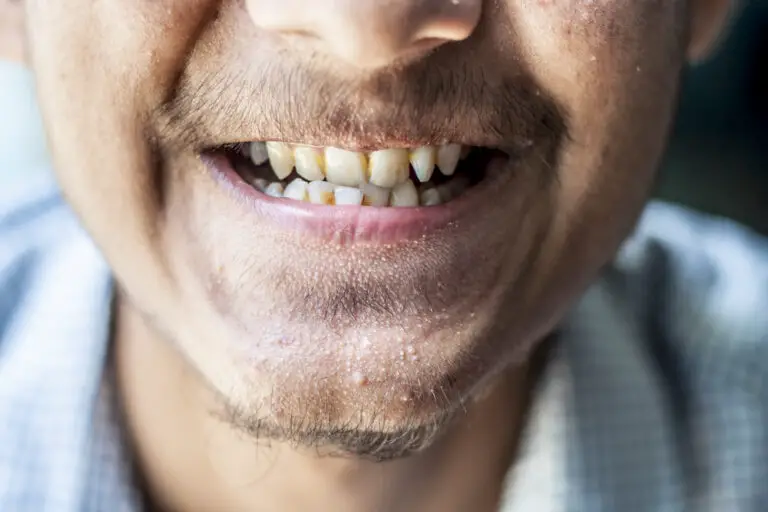Losing baby teeth and having permanent ones emerge is an exciting milestone for kids. But sometimes a new tooth never erupts to take the place of the lost baby tooth. This leaves a gap that seemingly stays the same size for months or years. As a parent, you may worry the permanent tooth is impacted, missing, or lost. But there are treatment options to restore your child’s smile.
Understanding the complex process of losing deciduous teeth and having adult teeth emerge is key. This helps you spot when something is not progressing normally. With early diagnosis and care from dentists, you can get your child’s smile back on track.
The Baby Teeth Eruption and Exfoliation Process

Baby teeth start forming in the womb before birth. The first set of deciduous teeth begin erupting around 6 months of age. This set of 20 teeth includes:
- 8 incisors (4 top, 4 bottom)
- 4 canines (2 top, 2 bottom)
- 8 molars (4 top, 4 bottom)
These deciduous teeth help a child chew and speak properly. They also hold space for permanent teeth developing under the gums.
Roots Dissolve as Permanent Teeth Develop
Below each baby tooth, the permanent tooth bud is forming within the jawbone. Around age 3, permanent molars emerge behind the last deciduous molars. Elsewhere, permanent incisors, canines, and premolars develop underneath their deciduous predecessors.
As the permanent teeth get closer to erupting, the roots of the baby teeth above them begin to dissolve. This helps the deciduous teeth become loose and eventually fall out.
Order of Deciduous Tooth Loss
Children lose their 20 baby teeth in a certain predictable order. This specific pattern allows permanent teeth to replace them properly.
The first teeth lost are typically the lower central incisors around age 6-7. These are followed by the upper central incisors around age 7-8. Next, the lower and upper lateral incisors and first molars come out between ages 8-10.
Between ages 10-12, the canines and second molars come out last. When all deciduous teeth have exfoliated, the set of 32 permanent teeth have taken their place.
Why Might a Permanent Tooth Not Emerge?
Typically, a permanent tooth erupts soon after the roots of the baby tooth above dissolve. But in some cases, a permanent tooth never emerges or erupts partially and becomes stuck. Reasons this may happen include:
Congenitally Missing Teeth
Also called tooth agenesis or anodontia, some children are born without one or more permanent teeth. The genetic condition causes these teeth to never form within the jaws. So when a baby tooth falls out, no permanent replacement is present. Missing incisors, premolars, and wisdom teeth are most common.
Physical Obstruction
A physical barrier in the pathway of the permanent tooth can prevent its eruption. Causes of blockage include:
- Extra baby teeth not yet exfoliated
- Impacted wisdom teeth limiting space
- Benign cysts or tumors blocking the crown
- Excess bone or gums covering the tooth
- Displaced teeth from an injury
Narrow Jaw Development
Some children naturally have jaws too small to accommodate all permanent teeth. So crowding and impacted teeth can result.
Premature Tooth Loss
Early extraction or trauma prematurely losing a baby tooth disrupts the eruption timing. spaces can close or teeth drift before the permanent tooth emerges.
Orthodontic Issues
Braces or retainers that are improperly timed can limit space and impede teeth from erupting. For example, pulling a deciduous incisor too early for braces may block its permanent replacement from emerging.
Cancer Treatment Side Effects
Radiation and chemotherapy drugs for cancer can damage developing permanent teeth. By killing rapidly dividing cells, these treatments may arrest tooth formation and prevent eruption.
Smoking During Pregnancy
Studies show maternal smoking during pregnancy is associated with missing and malformed permanent teeth in offspring. The toxins likely impact tooth development in utero.
Trauma Injuries
A severe mouth injury, especially during childhood, can damage developing permanent tooth buds. Roots may become fused to bone, preventing normal eruption.
Signs of a Missing Permanent Tooth

How do you know your child has a permanent tooth that is impacted or congenitally missing? Signs to watch for include:
- No eruption by age 12 after prematurely losing a deciduous tooth earlier
- Retention of a deciduous tooth beyond the normal exfoliation age
- A permanent tooth emerged on one side but not the matching space on the other side
- A gap or edentulous space that maintains the same width years after a deciduous tooth falls out
- A dental bridge with a false tooth replacing a missing permanent tooth
- Crowding or malpositioning of other teeth leaving a space
- No visible permanent tooth bud in x-ray imaging
Risks of Impaction & Tooth Loss
Leaving a gap long-term from a missing permanent tooth can negatively impact the teeth and oral health. Potential problems include:
- Progressive space loss – Teeth will naturally close gaps over time by tilting and rotating. This shrinks space for placing implants or fixed bridges later.
- Tooth decay – When deciduous teeth are retained too long due to a missing permanent replacement, they become prone to cavities. Decay can destroy their structure and function.
- Malocclusion – Shifted teeth no longer meet correctly, resulting in problems chewing and a “bad bite.” Open bites, crossbites, and overcrowding can occur.
- Periodontal disease – Missing teeth reduce stimulation to the jawbone in that area. This can lead to progressive bone loss and gum recession.
- Speech impairment – If missing anterior teeth are visible, it can affect pronunciation and speech.
- TMJ and muscle strain – Improper bite alignment from missing molars leads to uneven chewing forces that damage joints and muscles.
- GI problems – Molars are needed to grind food. Missing these teeth reduces chewing efficiency and can cause digestive issues.
- Facial profile changes – Gaps from multiple missing teeth cause cheek and lip support to decrease, resulting in premature aging of features. Jaw growth may also be asymmetric or stunted without the stimulus of teeth.
Diagnosing Impacted or Missing Permanent Teeth
If you notice gaps persisting after deciduous tooth loss, see your dentist right away for an exact diagnosis. They will perform these steps:
- Clinical exam – Check for visual signs like retained deciduous teeth, gaps, and malpositioning.
- Dental history – Review previous tooth loss, orthodontic treatment, injuries, and family genetics.
- X-ray images – Panoramic, bite wing, and periapical x-rays allow visualization of impacted or missing teeth below the gums.
- CBCT scan – A cone beam CT creates a 3D image of the jaws for better assessment than traditional x-rays.
- Study models – Impressions are taken to create stone models of the existing teeth alignment and fit.
Once a clear diagnosis is made, your dentist will explain treatment options to restore your child’s smile and prevent complications.
Treating Impacted and Congenitally Missing Teeth

Treating a missing permanent tooth requires a custom treatment plan tailored to your child’s specific condition. Common options include:
1. Monitoring Eruption
If your child is still young when a deciduous tooth is lost, dentists may first monitor eruption for several months before taking action. But diligent follow-up is required to avoid space loss or malocclusion.
2. Exposure Surgery
If a tooth appears impacted due to bone or soft tissue covering it, a minor surgical exposure can be done to free the pathway. This allows the tooth to finish erupting.
3. Orthodontic Movement
In many cases, braces and retainers are used to guide impacted teeth into proper alignment and function. But space must be maintained for the movement to work – if spaces close, extraction of deciduous teeth may help regain space.
4. Autotransplantation
An unerupted premolar can sometimes be transplanted into the space left by a missing anterior permanent tooth. This involves surgical removal and reimplantation of the premolar into the new site.
5. Tooth Restoration
Once growth is complete, missing teeth can be restored with dental implants, bridges, partial dentures, or retained deciduous teeth. But earlier restoration is ideal before bone loss occurs.
Discuss which options suit your child’s needs with an orthodontist, oral surgeon, and restorative dentist. Timing is critical, so initiating treatment before age 10 provides the best outcome.
Maintaining Deciduous Teeth Long-Term
If your child is missing multiple permanent teeth, retaining healthy deciduous teeth is often advised. This maintains bone, function, and space for future implants. To prolong deciduous teeth:
- Brush baby teeth twice daily with fluoride toothpaste
- Floss between teeth once daily
- Use antibacterial mouth rinse daily
- Apply pit and fissure sealants to molars
- Avoid sugary and acidic foods and drinks
- See the dentist every 3-4 months
- Take bitewing x-rays to monitor for decay
- Fill any cavities early to prevent worsening
- Use a mouthguard for sports to prevent trauma
With diligent care, deciduous teeth can frequently be maintained until the teenage years when more permanent restorations are placed after jaw growth completes.
Can Knocked-Out Permanent Teeth Be Replanted?
If a permanent tooth is prematurely extracted or avulsed (knocked out), there is a slim chance it can be replanted. But outcomes are best if done very soon after the injury before the tooth starts to dry out.
Factors impacting success include:
- Child’s age – Younger children with incompletely formed roots have higher long-term prognosis.
- Tooth maturity – Immature root formation allows continued development after replantation.
- Extraoral time – The tooth should be replanted within 30 minutes ideally, or at least within 1-2 hours.
- Storage medium – Keeping an avulsed tooth in milk or saline until replantation improves prognosis.
- Periodontal ligament status – Gently handle the tooth by the crown only. Do not scrub or damage the delicate root tissues.
- Replantation method – Rinse off tooth, align it, and insert slowly back into the socket without forcing.
- Use of antibiotics – Antibiotics are given to help prevent infection and inflammatory root resorption.
With optimal conditions, permanent tooth replantation allows for continued root development and tooth retention. But follow-up care like endodontic therapy, long-term antibiotics, and splinting are required to mitigate complications. Outcomes remain unpredictable. Your dentist can best advise you on the chances of success.
Conclusion
While losing baby teeth is normal, it can be alarming if the permanent tooth does not then erupt into the space. But with early diagnosis and care, complications like impaction and missing teeth can often be resolved. Orthodontic and surgical treatments can guide most permanent teeth into proper position and function. For congenitally missing teeth, space can be maintained until restorations are placed after jaw growth is complete.
With diligence and patience, your child can regrow their smile even if permanent teeth are initially impacted or undeveloped. Just be sure to see your dentist at the first sign of any gaps persisting after deciduous tooth loss. Catching issues quickly while your child’s mouth is still developing gives the best chance of restoring a complete and healthy smile they can enjoy for life.







